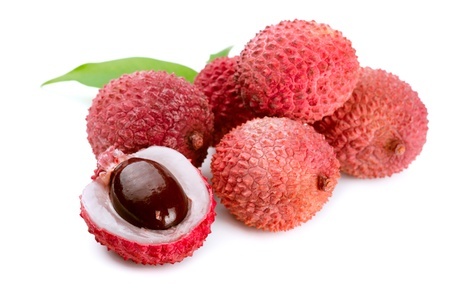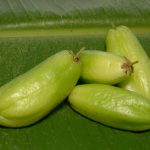
Litchi (Litchi chinensis) or lychee is mostly sourced from Southeast Asia, and is a tropical or subtropical crop that has seen a gentle and steady rise in cultivation for its fruits globally (Huang and Xu, 1983). The fruit has a vibrant red-brown skin and a peculiar savoury-sweet flavour. It is popularly consumed as a dessert in its syrup following a typical Chinese meal. One consequence of its popularity – the fruit has seen widely increasing exports especially to Europe and North America.
Composition:
The edible portion of litchi contains water (81.76 g), protein (0.83 g), lipids (0.44 g), ash (0.44 g), carbohydrates (16.53 g), fiber (fibre) (1.3g) and sugars (15.23 g) – all per 100g. Rutin levels are one of the highest of any fruit.
Studies On The Extract – Diabetes, Obesity And Metabolic Syndrome
A number of in-vitro and in-vivo studies explored the health benefits of litchi, suggesting that the fruit extract could ameliorate diabetes, obesity and complications associated with these conditions (Huang & Wu, 2002; Guo et al, 2004; Obrosova et al, 2010). It appears litchi fruit contains bioactive compounds that enhance the body’s immune system, and can protect it from diabetes or obesity induced chronic inflammation. The following studies provide illustration of this.
Oxidative stress is a trademark feature of a variety of chronic diseases (Spiteller, 1993). In diabetes, obesity and metabolic syndrome, the levels of oxidative stress which concerns the generation of reactive oxygen species (ROS) significantly increases with concomitant damage to both micro- and macrovascular tissues (Spiteller, 1993).
An early study showed their Litchi extract enhanced basal prostaglandin E2 (PGE2) production in a macrophage cell line (RAW264.7), which is a critical inhibitor of the inflammatory immune response (Huang & Wu (2002).
Heart, Blood And Anti-Inflammatory Benefits Of Litchi (Lychee).
A number of nutrients in lychees are associated with general good health let alone cardiovascular benefits especially blood production. The fruit has significant amounts of minerals, copper, iron, manganese and magnesium. The key vitamins are folate and vitamin C.
An important bioflavonoid is rutin which is found in other fruits. The bioflavonoids are linked to strong blood vessels and a reduction in the formation of varicose veins and hemorrhoids, as well as combating the effects of excessive and extensive bruising.
A flavonol-rich lychee fruit extract (FRLFE) has been examined for its potent anti-inflammatory properties. The extract appears to suppress inflammation and reduce tissue damage caused by intensive physical exercise as well as diseases such as arthritis and other inflammatory diseases (Yamanishi et al., 2014).
Litchi Polysaccharides
Litchi polysaccharides extracted from pulp tissue have high antioxidant capacities (Kong et al, 2010). Four polysaccharide-enriched fractions extracted from the pulp tissue of Litchi exhibited a dose-dependent free radical scavenging activity. One extract, LFP-III demonstrated the highest scavenging activity against the DPPH radical, and other radicals such as superoxide, and hydroxyl radicals using its absorption capabilities.
One study in rats, showed that feeding an extract of litchi water improved the metabolic profile of rats, by decreasing their body weight, improving their fasting blood glucose, lowering or maintaining blood levels of total cholesterol, triglycerides, and free fatty acids (FFAs), controlling leptin and fasting insulin levels (Guo et al, 2004). The same study discovered that it reduced the insulin resistance of these rats. Further studies then showed the anti-diabetic potential was due to the modulation of anti-inflammatory factors. For example, tumor necrosis factor (TNF-α), a cytokine involved with tissue inflammation, was significantly reduced after feeding litchi water extract to type 2 diabetic rats.
Glucose induced cataracts lead to blindness and other forms of retinopathy and is a debilitating complication resulting from uncontrolled diabetes in humans – a major issue (Cheung et al, 2010). Aldose reductase is the critical initiator of cataract formation (a.k.a. cataractogenesis) (Obrosova et al, 2010). This enzyme resides in the cornea, and catalyzes the first step in a polyol pathway that induces sorbitol formation. In diabetes or hyperglycaemia, aldose reductase activity rises leading to increased or excess formation of sorbitol. Cataracts develop because of high sorbitol accumulation in the cornea.
Methanol and ethylacetate extracts of litchi fruit pericarp (LFP) are potent inhibitors of rat lens aldose reductase in vitro. A novel anthocyanin colour, delphinidin- 3- O-β galactopyranoside-3′-O-β– glucopyranoside was isolated from the ethylacetate extract of LFP and exhibited potent inhibitory activity against rat lens aldose reductase. This suggests that LFP and its constituents contain potent inhibitors of aldose reductase, and can be used to prevent diabetes-induced blindness and retinopathy (Lee et al, 2009).
A new litchi derived polyphenol mixture, termed Oligonol ™ (Amino Up Chemical Co., Ltd., Sapporo, Japan) has been tested with great promise in preventing or reducing the impact of obesity especially on Metabolic Syndrome. The supplement significantly decreases the levels of ROS (reactive oxygen species) and uprates gene expression levels for the enzyme superoxide dismutase (SOD) in white and brown mouse adipocytes. This polyphenol mixture also attenuated the gene expression of the adipokines TNF-α, MCP-1, PAI-1, adiponectin and leptin in white adipocytes, which are heavily involved in the pathogenesis of obesity-associated metabolic syndrome. (Sakurai et al, 2008).
References
Cheung, N., Mitchell, P., Wong, T.Y. (2010) Diabetic retinopathy. Lancet. 376: pp. 124–36. [PubMed: 20580421]
Guo, J., Li, L., Pan, J., Qiu, G., Li, A., Huang, G., Xu, L.(2004) Pharmacological mechanism of Semen Litchi on antagonizing insulin resistance in rats with type 2 diabetes. Zhong Yao Cai. 27 pp. 435–8. [PubMed: 15524300]
Huang, H.B., Xu, J.K. (1983) The developmental pattern of fruit tissues and their correlative relationship in Litchi chinesis Sonn. Scientia Horticultureae. 19 pp. 335–342.
Huang, C.J., Wu, M.C. (2002) Differential effects of foods traditionally regarded as ‘heating’ and ‘cooling’ on prostaglandin E(2) production by a macrophage cell line. J. Biomedical Science. 9 pp. 596–606. [PubMed: 12432225]
Kong, F., Zhang, M., Liao, S., Yu, S., Chi, J., Wei, Z. (2010) Antioxidant activity of polysaccharide-enriched fractions extracted from pulp tissue of Litchi chinensis Sonn. Molecules. 15: pp. 2152–65. [PubMed: 20428034]
Lee, S.J., Park, W.H., Park, S.D., Moon, H.I. (2009) Aldose reductase inhibitors from Litchi chinensis Sonn. J. Enz. Inhib. Medicinal Chem. 24 pp. 957–9. [PubMed: 19555177]
Obrosova, I.G., Chung, S.S., Kador, P.F. (2010) Diabetic cataracts: mechanisms and management. Diabetes/Metabolism Res. Rev.. 26: pp.172–80. [PubMed: 20474067]
Sakurai, T., Nishioka, H., Fujii, H., Nakano, N., Kizaki, T., Radak, Z., Izawa, T., Haga, S., Ohno, H. (2008) Antioxidative effects of a new lychee fruit-derived polyphenol mixture, oligonol, converted into a low-molecular form in adipocytes. Biosci. Biotech. Biochem. 72 pp. 463–476
Spiteller, G. (1993) Review: on the chemistry of oxidative stress. J. Lipid Mediat. 7 pp.199–221. [PubMed: 8219002]
Yamanishi, R., Yoshigai, E., Okuyama, T., Mori, M., Murase, H., Machida, T., … Nishizawa, M. (2014). The Anti-Inflammatory Effects of Flavanol-Rich Lychee Fruit Extract in Rat Hepatocytes. PLoS ONE, 9(4), e93818. http://doi.org/10.1371/journal.pone.0093818


Leave a Reply